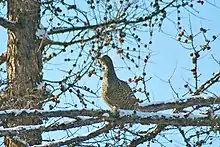Black-billed capercaillie
The black-billed capercaillie, eastern capercaillie, Siberian capercaillie, spotted capercaillie, or (in Russian) stone capercaillie[2] (Tetrao urogalloides), is a large grouse species closely related to the more widespread western capercaillie. It is a sedentary species which breeds in the larch taiga forests of eastern Siberia as well as parts of northern Mongolia and China. In the far west of its distribution, the black-billed capercaillie has been known to hybridize with the western capercaillie.
| Black-billed capercaillie | |
|---|---|
 | |
| Scientific classification | |
| Kingdom: | Animalia |
| Phylum: | Chordata |
| Class: | Aves |
| Order: | Galliformes |
| Family: | Phasianidae |
| Genus: | Tetrao |
| Species: | T. urogalloides |
| Binomial name | |
| Tetrao urogalloides Middendorff, 1853 | |
| Synonyms | |
|
Tetrao parvirostris[2] | |
Description

The length of a male black-billed capercaillie averages about 89–97 centimetres (35–38 in) and weigh at 3,350–4,580 grams (7.39–10.10 lb), with females measuring around 69–75 centimetres (27–30 in) and weighing 1,700–2,200 grams (3.7–4.9 lb).[3] Their wingspan stretches approximately 29 to 46 inches (75-115 cm) long.[4] Compared to the western capercaillie, it is slightly smaller in size with a slimmer body profile and longer neck, has a black beak (hence its name) instead of being horn-colored, and a longer, more spatulate tail. The eastern capercaillie has a somewhat glossy bluish-black head & neck down to a metallic turquoise breast. Distinct white markings at the tips of its upper tail and wing coverts coin this grouse the nickname 'spotted capercaillie'. The female is similar to that of its western counterpart, except that its plumage is grayer overall with more heavily-scaled underparts, lacks a solid rufous chest unlike the wood grouse, and has noticeably larger white spots on her wing and tail coverts.[5]
Behavior
From the crack of dawn until late morning, male capercaillies in the spring display by fanning out their tails, puffing their chest feathers out, lowering their wings, and angling their heads upward with an open beak to defend their space from other males and win over the mating rights of females. The size of the males' territories were usually 30 by 30 metres (98 ft × 98 ft), similar to black grouse territories, based on a research project by the University of Nebraska. A group of hens will carefully squat with drooping wings while the lekking male is present to signal that they're ready for breeding. Their castanets-like call can be heard up to 1.5 kilometres (0.93 mi) away, much louder than the western capercaillie. It consists of a series of loud repeating clicks ascending in tempo. Other performances used to attract females involve flutter flights. They jump off the ground (>2 metres (6.6 ft) high, 8–10 metres (26–33 ft) far have been recorded) and rapidly beat their wings during takeoff and landing, generating a thundering flurry that resonates through the dense stands of conifers.[6][7]
Subspecies
The University of Nebraska conducted a study on the morphological and regional differences of 3 identified subspecies, with leg feathers becoming thicker further north of this species's range as an adaptation to the harsher climate. The research team also noted that females of the southern or Mongolian subspecies (T. u. stegmanni) were more brown in color than those of the nominate subspecies:[6]
- T. urogalloides stegmanni - the mountain ranges of Mongolia south of the boreal forest
- T. urogalloides kamtschaticus - the Kamchatka peninsula
- T. urogalloides urogalloides (nominate) - much of the eastern Siberian taiga and tundra northeast to Chukotka
References
- BirdLife International (2016). "Tetrao urogalloides". The IUCN Red List of Threatened Species. IUCN. 2016: e.T22679491A92815954. doi:10.2305/IUCN.UK.2016-3.RLTS.T22679491A92815954.en. Retrieved 13 January 2018.
- "Tetrao parvirostris". Avibase.
- de Juana, Eduardo; Kirwan, Guy M. (2020-03-04). "Black-billed Capercaillie (Tetrao urogalloides)". Birds of the World.
- "Black-billed Capercaillie". www.oiseaux-birds.com. Retrieved 2020-07-21.
- "Oriental Bird Club Image Database : Black-billed Capercaillie » Tetrao urogalloides". orientalbirdimages.org. Retrieved 2020-10-16.
- Klaus, Siegfried; Schindlatz, Karl-Heniz; Andreev, Alexander; Bergmann, Hans-Heiner (2012-01-01). "Ecology and Behaviour of the Black-Billed Capercaillie ( Tetrao urogalloides stegmanni ) in the Khentej Mountains, Mongolia". Cite journal requires
|journal=(help) - Начало., retrieved 2020-10-16
